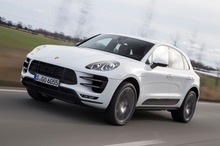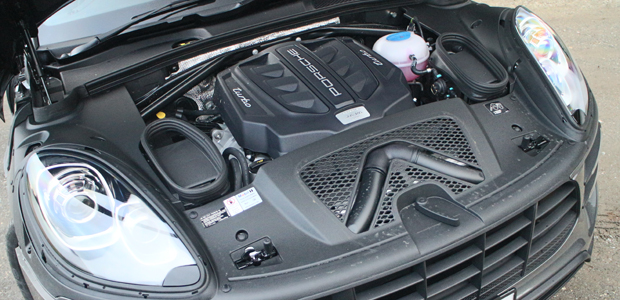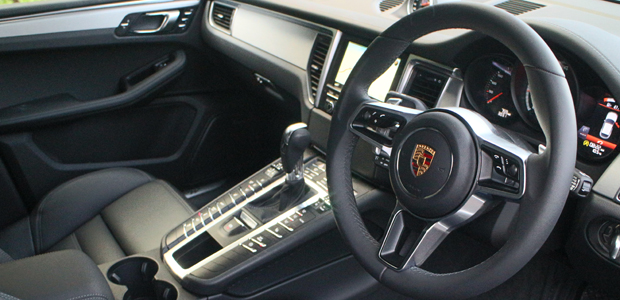Let's forget about the losers who worry about trivial matters like CPF savings and talk about issues that are far more relevant to a rich and successful country like Singapore instead.

The fastest, sexiest sport-ute on the market comes at a very hefty badge premium
<header>

By David Booth Originally published: 9 hours ago
</header>You’ve heard none of the hue and cry that accompanied the launch of the Cayenne. No Chicken Little “Porsche’s sky if falling” doomsday prophecies lamenting the diluting of the storied brand. Nor even the questioning of marketability that accompanies every model that threatens to stretch any brand. Indeed, the anoraks that decried the arrival of Porsche’s first SUV back in 2000 have uttered not a solitary peep at the arrival of this, Stuttgart’s second sports utility vehicle.
That’s, of course, because the Cayenne has been successful beyond even Porsche’s wildest dreams (the company sold more than 77,000 in 2012 alone), responsible — along with the four-door Panamera — not just for the survival of the brand but the kind of profitability that has allowed the company to expand its much-ballyhooed lineup of sports cars. Purists might blanch at the thought, but there is a 918 Spyder because Porsche has made so much money selling Cayennes. Ditto for seemingly uncountable variations of the 911 and something as relatively low on the sales volume chart as the Cayman. Those cars might never have seen the light of day if the people enthusiasts deride as dilettantes hadn’t been parking Cayennes in their garages in record numbers. So, don’t expect much controversy to accompany the introduction of Porsche’s latest profit-generating “truck”, the Macan.
Certainly, the naysayers will find little to complain about the Macan’s execution. Oh, there might be tut-tutting that it’s based on Audi’s Q5 — true but with substantial alterations — or that it might eventually be available with diesel and/or even four-cylinder engines. But, as delivered, the Macan Turbo is, as befits anything wearing the Porsche crest, the most sporting of SUVs.

The Macan’s cabin will come as no surprise to anyone who has sat inside a recent Porsche. The centre console is dominated by the performance modifying buttonry — suspension, traction control, etc. — that surrounds the gear lever.
The Turbo — a confusing moniker since both models are, in fact, powered by turbocharged V6s; a 3.0-litre for the S, a 3.6 for the Turbo — boasts a class-leading 400 horsepower (the S but 60-hp less) and can accelerate to 100 kilometres an hour in less than five seconds (the S is about half a tick behind). And while that’s slower than anything else wearing a Turbo badge in Porsche’s lineup, lack of power will never be a Macan complaint.
One thing that is surprising, however, is that those 400 horses are not the important number on the spec sheet. The Turbo boasts 406 of those foot-pound things and they’re available at such a low 1,350 rpm that one seldom sees the tachometer swing past 3,000 rpm in the course of everyday driving. Indeed, the seven-speed PDK consistently short shifts keeping the V6 in the lower echelons of its rev range; one really has to be deep in the throttle before you’ll get any serious engine revving. And, if there’s any disappointment at all to the Turbo’s performance, it’s that the twin-turbo’ed V6′s low-rpm response is so impressive down low that you expect it to build to an almost 918 crescendo at higher rpm when, it fact, it goes flat above about 5,000 rpm. Nonetheless, 4.8 seconds to 100 klicks — 4.6 with the Sports Chrono package — is amazing stuff for something that portends to go off-road.
Keeping the revs low does have positive benefits, though. One presumes it helps fuel economy, though the Macan Turbo’s 14.2 litres per 100 km in the city and 10.1 highway figures seem strikingly consumptive, that highway figure, for instance, worse than what Porsche claims for the Cayenne Turbo, two pistons richer and some 325 kilograms heavier. It is important to remember, though, that the Macan is using Natural Resources Canada’s new, more stringent five-cycle testing regimen so direct comparisons are not yet possible.
Nonetheless, keeping the revs down at least reduces the thrashiness typical of a V6 and, indeed, the Macan’s powertrain may be more impressive for its sophistication than its performance.

From all angles, the Macan is definitely a very sexy sport-ute.
The same impressing-beyond-its-humble-origins applies to the chassis. Yes, the 2,807-millimetre wheelbase is essentially the same as the Q5′s and, yes, the various suspension links and geometry are also identical (Porsche says that they were fully prepared to change it all, but that Audi did such a good job that they left well enough alone), but pretty much everything else has been Porschified. Dampers and spring rates are notably firmer, the tires are bigger and wider and the steering ratio is noticeably quicker. Porsche also incorporated its own electronically-controlled all-wheel-drive system that offers, says the company, more variation in torque splits than the quattro system’s mechanical diff. Whatever the case, the Macan features a decidedly rearward torque split, a trait emphasized when it is equipped with the company’s PTV torque-vectoring system (a $1,700 option). Not having a racetrack at my disposal, I did not test the efficacy of this last, but I can say that the overall result is a taut ride with precious little body roll and turn-in that is almost sports-car-like. Indeed, if there’s a reason to opt for the Macan’s comparatively small cargo space (17.6 cubic feet which is barely bigger than some sedans), it is its lithe, athletic steering. A few will complain that the steering is too heavy, but that extra effort results in steering feel uncommon in the SUV ranks.
The Macan’s cabin will come as no surprise to anyone who has sat inside a recent Porsche. The centre console is dominated by the performance modifying buttonry — suspension, traction control, etc. — that surrounds the gear lever. The upper console has all the multimedia gadgetry and there’s more to be had on the steering wheel. Truth be told, it’s all just a little too busy for my liking. Despite my ambivalence towards the multimedia controllers that proliferate these days, I found myself wishing some of this “noise” were programmed into the central computer, trotted out for the one or two times a month that one might access the sports suspension button or decide to pair yet another phone.
Another departure from my normal road tests will be to comment on the Macan’s exterior styling. Normally, since beauty is so much in the eye of the beholder, I would let the accompanying pictures speak their thousand words. But I find the Macan so fetching — and not just for an SUV — that I feel obliged to comment. Depending on your viewpoint, it can be seen as the Cayenne distilled — it looks lithe while the Cayenne always seems a little football-lineman-gone-to-seed to me — or perhaps a big Boxster wagon. I see a little of BMW’s odd little M Coupe in the Macan, slightly boated yes, but pugnaciously sporty nonetheless.

Pricing for the 2014 Porsche Macan Turbo can get very high, very fast. A fully optioned out Macan will cost you just over $100,000.
With performance worthy of the badge, styling equal to the best of the segment and aimed at the fastest growing segment in the luxury market, the Macan is well positioned to continue the success hewed by the Cayenne. Faults are few, though, in the case of the Turbo version at least, significant. For one, the Lane Keep Assist program is simply wonky as all get out. Unlike, say, the Mercedes-Benz system on the S-Class, which could convince you that the era of autonomous driving is nigh at hand, left to its own devices (i.e. taking your hands off the wheel), the Macan snakes down the road like a pre-Oprah Lindsay Lohan weaving down Sunset Boulevard. Not only does it bounce from lane marker to lane marker like a drunken sailor, but its resistance to simply approaching painted lines is quite obtrusive. I tested it just long enough to become suitably annoyed and then shut it off.
The safety nanny may be annoying, but it is hardly a deal breaker. More difficult to justify is the Turbo’s pricing. Although the S model starts at a reasonable, we’re-just-trying-to-get-you-in-the-door $54,300, the Turbo rings in at a positively pricey $82,000. And my tester’s sticker topped out at a seriously usurious $102,685, including $1,670 for a rearview camera (which surely should be standard on an $82,000 compact sport ute) and $3,700 for a set of wheels. Hell, despite forking out 100 large, you’re still making do with a relatively crummy Bose audio system (as opposed to, say, a top-shelf Bang & Olufsen system) and a climate control system with only two adjustment zones (available on a $33,599 Hyundai Tucson Limited and a Toyota RAV4 for even less).
Porsche’s station in the marketplace is indeed exalted. And the Macan is without a doubt the fastest, best performing and possibly sexiest sport-ute on the market. But you’ve got to be pretty desperate for Stuttgart cresting to pay almost $50,000 more than the base price of an SQ5. This pricing premium was the one valid criticism leveled at the original Cayenne (versus the Volkswagen Touareg on which it was based). It remains Porsche’s most significant fault in general and the one chink in the Macan Turbo’s otherwise bullet-proof armour.

2014 Porsche Macan Turbo
Porsche’s pricing is positively off-the-wall
If free market capitalism teaches us anything, it is that nothing has an “intrinsic” value; any product — from a lowly can of fizzy pop to the most expensive of Italian supercars — is only worth what the market will bear. And bear is something the market has chosen to do with all Porsche products, all the company’s cars demanding a premium for their Teutonic engineering. Nonetheless, I have to say that I found the Macan Turbo’s pricing especially egregious.
So I took the time explore what I might buy as an alternative to my $102,865 Macan Turbo purchase. For instance, I found that if I anted up a little less than $15,000 more, I could buy a base Audi RS7. True, they are not direct competitors and Stuttgart’s branding is definitely haughtier than Ingolstadt’s, but the 560-hp Audi is the best thing on four wheels that money can currently buy, so one would be a fool not to consider it.
One could also, for the same money, drive around in the base version of Land Rover’s Range Rover, a brand surely equally prestigious to Porsche and a model at least two rungs higher up the luxury ladder than the Macan. Did I mention that the Range Rover features (costly) all-aluminum construction and a supercharged V8?
Starting with the same brand, one could option out a Range Rover Evoque — the Macan’s equal in style and status if not quite power — and still have enough left over for a well turned-out BMW 428i (without the xDrive all-wheel-drive option, however).
Alternatively, you could get a spunky little Mini Cooper S, a fully-decked out Harley-Davidson Electra Glide and still have enough left over for a Mercedes-Benz GLK … with the V6 and a few options.
There is absolutely nothing wrong with Porsche asking $100,000+ for a fully-optioned Macan Turbo. If people are willing to pay such a premium for the luxury of boasting the famous crest, then Porsche would be stupid not to take their money. On the other hand, one has to believe that there will eventually be a limit to such indulgence. As I see it, the Macan Turbo makes an excellent $70,000 (stretching to perhaps $85,000 with options) performance sport-ute. A hundred large would see me seriously shopping the S model or even Audi SQ5.

2014 Porsche Macan Turbo
The Specs
Type of vehicle All-wheel-drive compact sport utility
Engine 3.6L DOHC turbocharged V6
Power 400 hp @ 6,000 rpm; 406 lb.-ft. of torque @ 1,350 to 4,500 rpm
Transmission Seven-speed PDK
Brakes Four-wheel disc with ABS
Tires P295/35R21 rear; 265/40R21 front
Price (base/as tested) $82,200/$102,685
Destination charge $1,155
Natural Resources Canada fuel economy (L/100 km) 14.2 city, 10.1 highway
Standard features Power door locks, windows and power mirrors, dual-zone electronically-controlled air conditioning with micron air filter, Bose 545-watt AM/FM/CD player with 14 speakers, Bluetooth connectivity, navigation system, Multifunction steering wheel controls, cruise control, information display, tilt and telescoping steering wheel, 18-way adjustable leather front seats, heated front seats, heated steering wheel, 40/20/40 rear folding seats, auto headlights, four 12 volt power sockets, dual front air bags, driver’s side knee air bag, dual front side air bags, side curtain air bags, front knees air bags, Porsche Stability Management (PSM)











